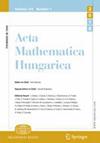关于平方的乘积表示
IF 0.6
3区 数学
Q3 MATHEMATICS
引用次数: 0
摘要
修复 \(k \geq 2\). 对于任何 \(N \geq 1\),让 \(F_k(N)\) 的最大子集的基数 \(\{1,\dots,N\}\) 它不包含 \(k\) 乘积为平方的不同元素。Erdős, Sárközy和Sós显示了这一点 \(F_2(N) = (\frac{6}{\pi^2}+o(1)) N\), \(F_3(N) = (1-o(1))N\), \(F_k(N) \asymp N/\log N\) 对于偶数 \(k \geq 4\),和 \(F_k(N) \asymp N\) 对于奇数 \(k \geq 5\). Erdős然后问是否 \(F_k(N) = (1-o(1)) N\) 对于奇数 \(k \geq 5\). 使用概率论证,我们以否定的方式回答这个问题。本文章由计算机程序翻译,如有差异,请以英文原文为准。
On product representations of squares
Fix \(k \geq 2\). For any \(N \geq 1\), let \(F_k(N)\) denote the cardinality of the largest subset of \(\{1,\dots,N\}\) that does not contain \(k\) distinct elements whose product is a square. Erdős, Sárközy, and Sós showed that \(F_2(N) = (\frac{6}{\pi^2}+o(1)) N\), \(F_3(N) = (1-o(1))N\), \(F_k(N) \asymp N/\log N\) for even \(k \geq 4\), and \(F_k(N) \asymp N\) for odd \(k \geq 5\). Erdős then asked whether \(F_k(N) = (1-o(1)) N\) for odd \(k \geq 5\). Using a probabilistic argument, we answer this question in the negative.
求助全文
通过发布文献求助,成功后即可免费获取论文全文。
去求助
来源期刊
CiteScore
1.50
自引率
11.10%
发文量
77
审稿时长
4-8 weeks
期刊介绍:
Acta Mathematica Hungarica is devoted to publishing research articles of top quality in all areas of pure and applied mathematics as well as in theoretical computer science. The journal is published yearly in three volumes (two issues per volume, in total 6 issues) in both print and electronic formats. Acta Mathematica Hungarica (formerly Acta Mathematica Academiae Scientiarum Hungaricae) was founded in 1950 by the Hungarian Academy of Sciences.

 求助内容:
求助内容: 应助结果提醒方式:
应助结果提醒方式:


